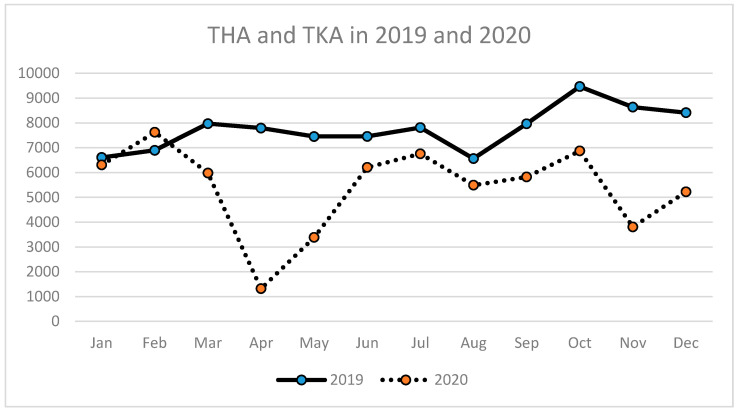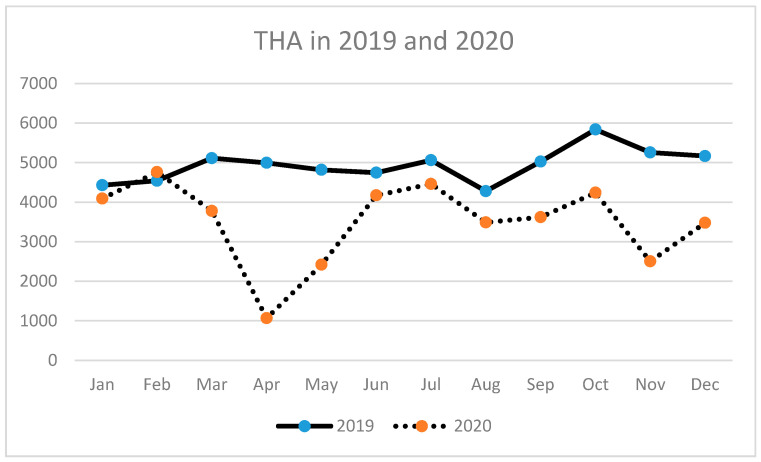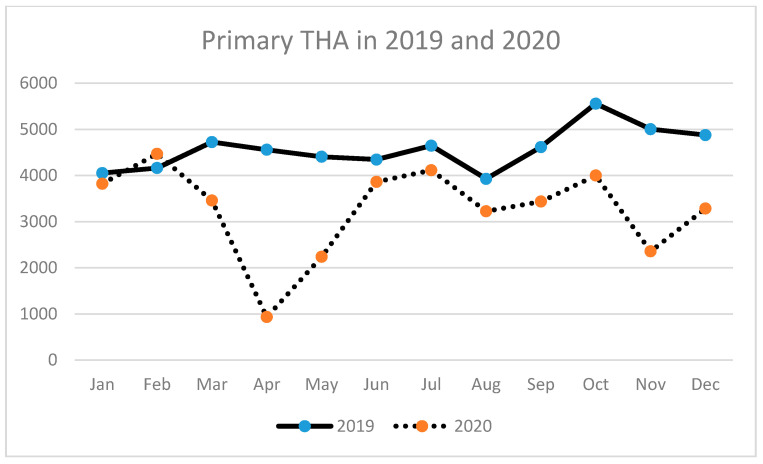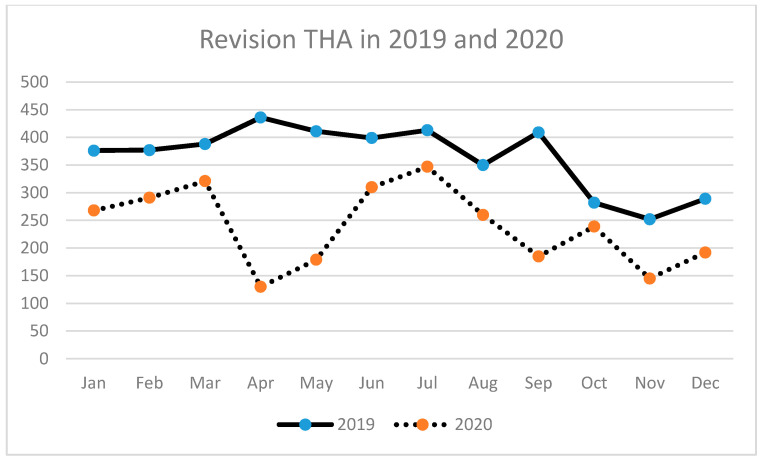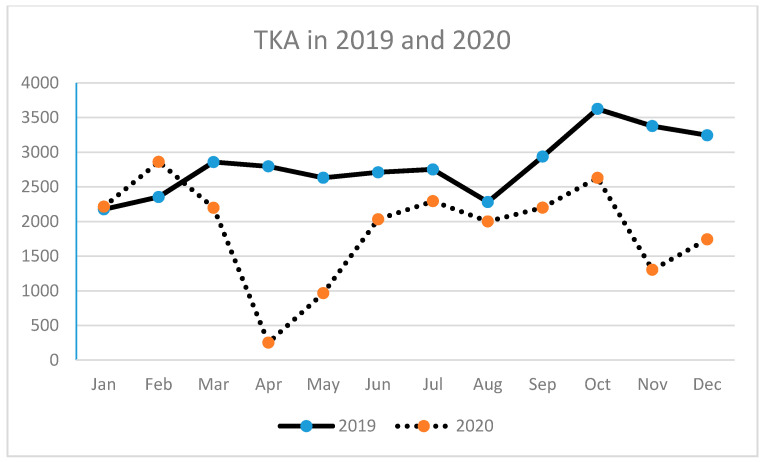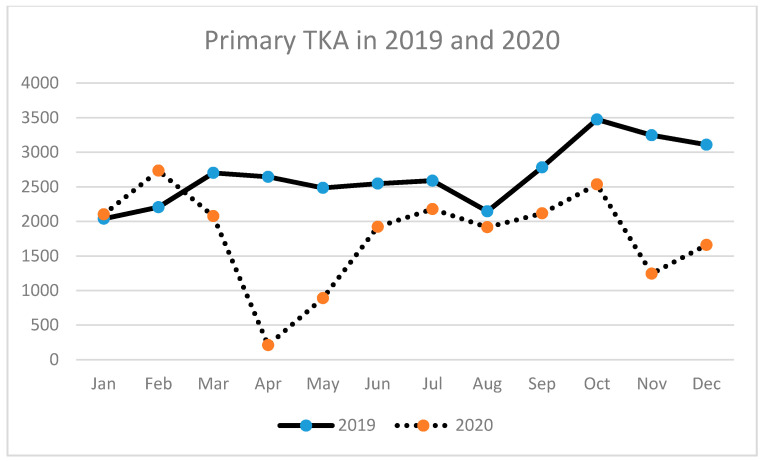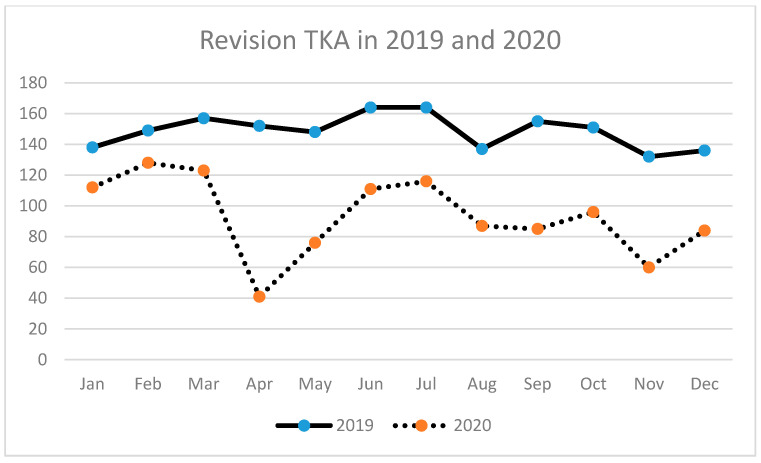Abstract
The aim of this study was to analyse the effect of the first year of the COVID-19 pandemic on total hip arthroplasty (THA) and total knee arthroplasty (TKA) surgical volume in Poland. A retrospective analysis of data concerning THA and TKA collected by the National Health Fund in Poland in 2019 and in 2020 has been conducted. The number of primary hip or knee arthroplasties in 2020 was around 71% and 67% of the number registered in 2019, respectively. There was also a decline in the volume of revision arthroplasties observed, with 65% and 63% of THA and TKA revisions performed in 2019. The most significant decrease was observed in April and May, and during the second wave of the pandemic in November 2020, with a decline of 87%, 55% and 56%, respectively. The results of this study show the significant impacts that the COVID-19 pandemic had on the volume of elective hip and knee arthroplasties in Poland in 2020. In comparison with 2019, a decrease of around 30% for primary and of 40% for revision arthroplasties was observed. The most significant decline was observed in April and May 2020, and during the second wave of the COVID-19 pandemic in Poland in November 2020.
Keywords: arthroplasty, COVID-19, total hip arthroplasty, total knee arthroplasty, revision arthroplasty
1. Introduction
Total hip arthroplasty (THA) and total knee arthroplasty (TKA) have been proven as the [1] methods of choice in the treatment of end-stage hip or knee pathologies [2,3,4,5]. Improvement in biomaterials, surgical techniques and implant designs has been the reason for more indications for THA and TKA [1,3,4,6,7,8,9].
Thus, the number of total joint arthroplasties has been increasing in the recent decades [10,11,12].
A steady increase in volume of THA and TKA in the United States has been projected up to 2030, with no negative influence of economic downturns in the 2000s [11,12,13,14,15].
The vast majority of THA and TKA procedures in Poland are covered by the National Health Fund (NFZ—Narodowy Fundusz Zdrowia), even in private hospitals. The number of both surgical procedures in Poland has been increasing, similarly to data reported for other countries [16,17].
COVID-19 infection was announced as a global pandemic by the World Health Organisation on 11 March 2020 [18]. The first confirmed case of SARS-Cov-2 infection in Poland was reported on 4 March 2020, and on 13 March, the Polish government implemented regulations reducing the functioning of most institutions and enterprises. There were 21 hospitals around Poland transformed into centres dedicated to the treatment of patients with COVID-19 infections. These hospitals were providing comprehensive care to patients infected with COVID-19, including the orthopaedic and traumatology departments. In order to prevent the health system overload and to provide the best care for SARS-CoV-2-infected patients, other medical institutions were recommended to reduce the number of elective admissions and surgical procedures. The cancellation of non-urgent elective surgeries severely affected the number of orthopaedic procedures, including THA and TKA. Due to a relatively low number of COVID-19 cases in Poland, elective procedures were progressively resumed in June 2020. In fall, the number of COVID-19 cases increased, however no official recommendations regarding elective orthopaedic surgeries were released.
To date, the real impact of the COVID-19 pandemic on THA and TKA in Poland has not been published.
The aim of this study was to analyse the effect of the first year of the COVID-19 pandemic on THA and TKA surgical volume in Poland.
2. Materials and Methods
This study was approved by the Institutional Review Board (protocol #nr 45/2021). A retrospective analysis of the registry data of THA and TKA funded by the National Health Fund in Poland in 2019 and in 2020 has been conducted. The data were collected by and obtained from NFZ.
The total numbers of the hip and knee arthroplasties performed in 2019 and 2020 have been compared. The volume of THA and TKA performed in the particular months was analysed and compared between 2019 and 2020. The analyses were taken for the total number of THA and TKA, THA or TKA separately and for the primary and revision THA and TKA, respectively.
Descriptive statistics and graphs (Microsoft Excell 365; Redmont, WA, USA) were used to present the data.
3. Results
The total number of both THA and TKA was 93,022 and 64,791 in 2019 and 2020, respectively (Table 1). The number of surgical procedures in 2020 ranged from 63% to 71% compared to 2019 (Table 1).
Table 1.
Numbers of total hip arthroplasties (THA) and total knee arthroplasties (TKA) performed in 2019 and 2020 in Poland.
| Procedure | Year | ||
|---|---|---|---|
| 2019 | 2020 | 2020/2019 (%) | |
| THA + TKA | 93,022 | 64,791 | 70 |
| THA | 59,277 | 42,089 | 71 |
| TKA | 33,745 | 22,702 | 67 |
| Primary THA | 54,895 | 39,222 | 71 |
| Primary TKA | 31,962 | 21,583 | 68 |
| Revision THA | 4382 | 2867 | 65 |
| Revision TKA | 1783 | 1119 | 63 |
The number of TKA and THA performed in the particular months of 2019 and 2020 is presented in Table 2. The decrease in arthroplasty surgical volume in 2020 compared to 2019 has been observed since March, with the lowest number of surgeries in April and May, with a subsequent gradual increase within the next 4 months and a drop in November with the second wave of the COVID-19 pandemic (Table 2, Figure 1).
Table 2.
Number of total hip arthroplasties (THA) and total knee arthroplasties (TKA) performed in the particular months of 2019 and 2020 in Poland.
| Number of THA and TKA | |||
|---|---|---|---|
| Year | 2019 | 2020 | 2020/2019 (%) |
| Month | |||
| January | 6606 | 6306 | 95 |
| Februrary | 6895 | 7624 | 111 |
| March | 7972 | 5979 | 75 |
| April | 7791 | 1318 | 17 |
| May | 7451 | 3385 | 45 |
| June | 7456 | 6207 | 83 |
| July | 7813 | 6757 | 86 |
| August | 6561 | 5490 | 84 |
| September | 7964 | 5823 | 73 |
| October | 9465 | 6871 | 73 |
| November | 8636 | 3808 | 44 |
| December | 8412 | 5223 | 62 |
Figure 1.
Number of total hip arthroplasties (THA) and total knee arthroplasties (TKA) performed in the particular months of 2019 and 2020 in Poland.
A similar tendency has been observed for THA (primary and revision) (Table 3, Figure 2, Figure 3 and Figure 4) as well as for TKA (primary and revision) (Table 4, Figure 5, Figure 6 and Figure 7).
Table 3.
Number of total hip arthroplasties (THA) performed in the particular months of 2019 and 2020 in Poland.
| Total THA | Primary THA | Revision THA | |||||||
|---|---|---|---|---|---|---|---|---|---|
| Year | 2019 | 2020 | 2020/2019 (%) |
2019 | 2020 | 2020/2019 (%) |
2019 | 2020 | 2020/2019 (%) |
| Month | |||||||||
| January | 4430 | 4092 | 92 | 4054 | 3824 | 94 | 376 | 268 | 71 |
| Februrary | 4541 | 4762 | 105 | 4164 | 4471 | 107 | 377 | 291 | 77 |
| March | 5114 | 3780 | 74 | 4726 | 3459 | 73 | 388 | 321 | 83 |
| April | 4995 | 1066 | 21 | 4559 | 936 | 21 | 436 | 130 | 30 |
| May | 4819 | 2419 | 50 | 4408 | 2240 | 51 | 411 | 179 | 44 |
| June | 4746 | 4174 | 88 | 4347 | 3864 | 89 | 399 | 310 | 78 |
| July | 5061 | 4463 | 88 | 4648 | 4116 | 89 | 413 | 347 | 84 |
| August | 4279 | 3488 | 82 | 3929 | 3228 | 82 | 350 | 260 | 74 |
| September | 5027 | 3622 | 72 | 4618 | 3437 | 74 | 409 | 185 | 45 |
| October | 5840 | 4240 | 73 | 5558 | 4001 | 72 | 282 | 239 | 85 |
| November | 5258 | 2504 | 48 | 5006 | 2359 | 47 | 252 | 145 | 58 |
| December | 5167 | 3479 | 67 | 4878 | 3287 | 67 | 289 | 192 | 66 |
Figure 2.
Number of total hip arthroplasties (THA) performed in the particular months of 2019 and 2020 in Poland.
Figure 3.
Number of primary total hip arthroplasties (THA) performed in the particular months of 2019 and 2020 in Poland.
Figure 4.
Number of revision total hip arthroplasties (THA) performed in the particular months of 2019 and 2020 in Poland.
Table 4.
Number of total hip arthroplasties (THA) performed in the particular months of 2019 and 2020 in Poland.
| Total THA | Primary THA | Revision THA | |||||||
|---|---|---|---|---|---|---|---|---|---|
| Year | 2019 | 2020 | 2020/2019 (%) |
2019 | 2020 | 2020/2019 (%) |
2019 | 2020 | 2020/2019 (%) |
| Month | |||||||||
| January | 2176 | 2214 | 102 | 2038 | 2102 | 103 | 138 | 112 | 81 |
| Februrary | 2354 | 2862 | 122 | 2205 | 2734 | 124 | 149 | 128 | 86 |
| March | 2858 | 2199 | 77 | 2701 | 2076 | 77 | 157 | 123 | 78 |
| April | 2796 | 252 | 9 | 2644 | 211 | 8 | 152 | 41 | 27 |
| May | 2632 | 966 | 37 | 2484 | 890 | 36 | 148 | 76 | 51 |
| June | 2710 | 2033 | 75 | 2546 | 1922 | 75 | 164 | 111 | 68 |
| July | 2752 | 2294 | 83 | 2588 | 2178 | 84 | 164 | 116 | 71 |
| August | 2282 | 2002 | 88 | 2145 | 1915 | 89 | 137 | 87 | 64 |
| September | 2937 | 2201 | 75 | 2782 | 2116 | 76 | 155 | 85 | 55 |
| October | 3625 | 2631 | 73 | 3474 | 2535 | 73 | 151 | 96 | 64 |
| November | 3378 | 1304 | 39 | 3246 | 1244 | 38 | 132 | 60 | 45 |
| December | 3245 | 1744 | 54 | 3109 | 1660 | 53 | 136 | 84 | 62 |
Figure 5.
Number of total knee arthroplasties (TKA) performed in the particular months of 2019 and 2020 in Poland.
Figure 6.
Number of primary total knee arthroplasties (TKA) performed in the particular months of 2019 and 2020 in Poland.
Figure 7.
Number of revision total knee arthroplasties (TKA) performed in the particular months of 2019 and 2020 in Poland.
4. Discussion
In this study, we present an analysis of the real impact of the COVID-19 pandemic on the number of THA and TKA in Poland. Such an analysis has not yet been published. COVID-19 had a significant effect on the hip and knee arthroplasty surgical volume in the first year of the pandemic in Poland. According to our analysis of data collected by the NFZ, the numbers of primary THA and TKA in 2020 were around 71% and 67% of the numbers registered in 2019, respectively. The decline in the volume of revision arthroplasties was even greater, with 65% and 63% of THA and TKA revisions performed in 2019.
The most significant decrease in the number of procedures was observed in April and May 2020, which was at the time of the strictest lockdown regulations in Poland. The relatively low number of cases during the first wave of the pandemic enabled Polish hospitals to resume elective surgical procedures, which resulted in higher numbers of arthroplasty procedures between June and September 2020. The second wave of the pandemic in the fall of 2020 resulted again in a decrease in the number of procedures, with the second lowest amount observed in November 2020, in accordance with the peak number of COVID-19 cases in Poland.
The impact of COVID-19 on arthroplasty was observed in many countries all around the world. According to Yapp et al., who analysed the data from the Scottish Arthroplasty Project, the number of primary THA and TKA procedures during the COVID-19 pandemic in Scotland fell by 53.6% and 61.1%, respectively. After resuming elective surgical procedures, Scottish hospitals achieved only 40–50% of the previous monthly volume [19]. An even bigger decrease of arthroplasty volume was observed at the beginning of the epidemic in the United States of America. Barnes et al. reported a significant decline in TKA and THA surgical volumes in mid-March 2020, of 94% and 92%, respectively [20]. According to Chia-Lung Shih et al., even though the epidemiological situation in Taiwan differed from that observed in the US or Scotland, with a very small number of COVID-19 cases and no restrictions concerning the elective surgical procedures, the volume of orthopaedic surgeries decreased by 20–30%. The decrease in orthopaedic surgical procedures in Taiwan in March and April 2020 could be associated with the patients’ fear of COVID-19 infection [21]. According to a survey conducted among the members of the European Hip Society and the European Knee Associates in April 2020, the procedures mostly disrupted by COVID-19 were primary total joint arthroplasty (92.6% cancelled) and aseptic revisions (94.7% cancelled), while 87.2% of periprosthetic fractures, 75.8% of hip arthroplasty for femoral neck fractures and 75.8% of septic revisions for acute infections were performed [22].
In the study by Clement et al., perioperative COVID-19 infection doubled the risk of postoperative mortality in orthopaedic and trauma patients in the UK, although most COVID-19 infections were observed in trauma patients (60 patients), with only 2 in elective orthopaedic procedures [23].
The results of our study confirm how large of an impact COVID-19 had on the joint arthroplasty volume in 2020. The large number of cancelled or postponed surgeries resulted in significant financial losses of medical institutions, changes in clinical practice of orthopaedic surgeons, as well as a profound effect on the physical, psychological and financial status of the patients awaiting the joint replacement [24,25,26,27,28,29]. Furthermore, younger patients with higher pain levels and worse joint function were more eager to proceed with the surgery, despite the pandemic [27,29]. Despite the impaired quality of life, most patients awaiting total joint arthroplasty (TJA) understood the need for the surgery delay due to the pandemic and said it was in their best interest [30].
The COVID-19 pandemic not only caused diminution of surgical procedures, but also severely impaired the post-operative care, including physical rehabilitation and surgeons’ follow-ups [25].
Several articles have discussed the resuming of elective joint arthroplasties during the COVID-19 pandemic [31,32,33,34]. Guidelines included reorganisation of hospital wards, patients’ selection and preoperative, perioperative and postoperative management. In the initial phase after resuming elective procedures, it was recommended to operate on patients with good general health status (ASA I and II) using spinal or regional anaesthesia, minimise the surgical and hospitalisation time, use absorbable sutures for wound closure, include telemedicine in the patient’s follow-up and provide a home care physical therapy [31,34]. Nevertheless, restarting and achieving the pre-pandemic volume of elective TJA has been a challenge for orthopaedic surgeons all around the world. According to our data, the gap between the number of arthroplasties performed in Poland in 2020 and 2019 was 28,231. Concerning the increasing trend in arthroplasty procedures in Poland, the real number of patients awaiting joint replacement was probably higher. Assuming 110% of pre-pandemic productivity, it will take around 3 years to catch up with the demand. According to other studies, it is projected that even with 120% pre-COVID productivity, the catch up will take from 1 to 4 years [19,35].
A potential limitation of our study is in the paucity of data available in the registry we used for the analyses. It might be valuable to perform detailed analyses including the age or sex of patients operated on in 2019 and in 2020. Furthermore, the correlations with the type of the hospital or specific region of Poland and the number of TKA and THA in the specific years would be of great value. However, to date, these data are still not available.
5. Conclusions
In summary, our results show the significant impact that the COVID-19 pandemic had on the volume of elective hip and knee arthroplasty in Poland. In comparison with 2019, a decrease of around 30% for primary arthroplasties and an even larger decrease of 40% for revision THA and TKA were observed in the first year of the pandemic. The most significant decrease in the volume of arthroplasties was observed in April and May 2020, and during the second wave of the COVID-19 pandemic in Poland in November 2020. Restoring previous capacity and catching up poses a great challenge for the healthcare system and all orthopaedic surgeons.
Author Contributions
Study design, M.C.-W., J.C. and M.T.; Data collection, M.C.-W., J.C. and M.T.; Statistical analysis, M.C.-W., D.G. and M.T.; Data interpretation, M.C.-W., J.C., D.G. and M.T.; Manuscript preparation, M.C.-W., J.C., D.G. and M.T.; Literature search, M.C.-W. and M.T. All authors have read and agreed to the published version of the manuscript.
Funding
There was no financial support associated with the preparation of this manuscript.
Institutional Review Board Statement
The study was approved by the Centre of Postgraduate Medical Education Institutional Review Board (protocol #nr 45/2021).
Informed Consent Statement
Not applicable.
Data Availability Statement
The data presented in this study are available upon request from the corresponding author and online: Publikacje/O NFZ/Narodowy Fundusz Zdrowia (NFZ)—finansujemy zdrowie Polaków.
Conflicts of Interest
All authors declare that they have no conflict of interest.
Footnotes
Publisher’s Note: MDPI stays neutral with regard to jurisdictional claims in published maps and institutional affiliations.
References
- 1.Batailler C., Swan J., Marinier E.S., Servien E., Lustig S. New Technologies in Knee Arthroplasty: Current Concepts. J. Clin. Med. 2020;10:47. doi: 10.3390/jcm10010047. [DOI] [PMC free article] [PubMed] [Google Scholar]
- 2.Karachalios T., Komnos G., Koutalos A. Total hip arthroplasty: Survival and modes of failure. EFORT Open Rev. 2018;3:232–239. doi: 10.1302/2058-5241.3.170068. [DOI] [PMC free article] [PubMed] [Google Scholar]
- 3.Dalury D.F. Cementless total knee arthroplasty: Current concepts review. Bone Jt. J. 2016;98-B:867–873. doi: 10.1302/0301-620X.98B7.37367. [DOI] [PubMed] [Google Scholar]
- 4.Hampton M., Mansoor J., Getty J., Sutton P.M. Uncemented tantalum metal components versus cemented tibial components in total knee arthroplasty: 11- to 15-year outcomes of a single-blinded randomized controlled trial. Bone Jt. J. 2020;102-B:1025–1032. doi: 10.1302/0301-620X.102B8.BJJ-2019-1448.R1. [DOI] [PubMed] [Google Scholar]
- 5.Learmonth I.D., Young C., Rorabeck C. The operation of the century: Total hip replacement. Lancet. 2007;370:1508–1519. doi: 10.1016/S0140-6736(07)60457-7. [DOI] [PubMed] [Google Scholar]
- 6.Buddhdev P.K., Vanhegan I.S., Khan T., Hashemi-Nejad A. Early to medium-term outcomes of uncemented ceramic-bearing total hip arthroplasty in teenagers for paediatric hip conditions. Bone Jt. J. 2020;102-B:1491–1496. doi: 10.1302/0301-620X.102B11.BJJ-2020-0668.R1. [DOI] [PubMed] [Google Scholar]
- 7.Hasan S., van Hamersveld K.T., Marang-van de Mheen P.J., Kaptein B.L., Nelissen R.G., Toksvig-Larsen S. Migration of a novel 3D-printed cementless versus a cemented total knee arthroplasty: Two-year results of a randomized controlled trial using radiostereometric analysis. Bone Jt. J. 2020;102-B:1016–1024. doi: 10.1302/0301-620X.102B8.BJJ-2020-0054.R1. [DOI] [PubMed] [Google Scholar]
- 8.Banger M.S., Johnston W.D., Razii N., Doonan J., Rowe P.J., Jones B.G., MacLean A.D., Blyth M.J.G. Robotic arm-assisted bi-unicompartmental knee arthroplasty maintains natural knee joint anatomy compared with total knee arthroplasty: A prospective randomized controlled trial. Bone Jt. J. 2020;102-B:1511–1518. doi: 10.1302/0301-620X.102B11.BJJ-2020-1166.R1. [DOI] [PMC free article] [PubMed] [Google Scholar]
- 9.Karachalios T., Komnos G.A. Individualized surgery in primary total knee arthroplasty. EFORT Open Rev. 2020;5:663–671. doi: 10.1302/2058-5241.5.190085. [DOI] [PMC free article] [PubMed] [Google Scholar]
- 10.Sloan M., Premkumar A., Sheth N.P. Projected Volume of Primary Total Joint Arthroplasty in the U.S., 2014 to 2030. J. Bone Jt. Surg. Am. Vol. 2018;100:1455–1460. doi: 10.2106/JBJS.17.01617. [DOI] [PubMed] [Google Scholar]
- 11.Losina E., Thornhill T.S., Rome B.N., Wright J., Katz J.N. The Dramatic Increase in Total Knee Replacement Utilization Rates in the United States Cannot Be Fully Explained by Growth in Population Size and the Obesity Epidemic. J. Bone Jt. Surg. Am. Vol. 2012;94:201–207. doi: 10.2106/JBJS.J.01958. [DOI] [PMC free article] [PubMed] [Google Scholar]
- 12.Kremers H.M., Larson D.R., Crowson C.S., Kremers W.K., Washington R.E., Steiner C.A., Jiranek W.A., Berry D.J. Prevalence of Total Hip and Knee Replacement in the United States. J. Bone Jt. Surg. Am. Vol. 2015;97:1386–1397. doi: 10.2106/JBJS.N.01141. [DOI] [PMC free article] [PubMed] [Google Scholar]
- 13.Kurtz S.M., Ong K.L., Lau E., Bozic K.J. Impact of the Economic Downturn on Total Joint Replacement Demand in the United States: Updated projections to 2021. J. Bone Jt. Surg. Am. Vol. 2014;96:624–630. doi: 10.2106/JBJS.M.00285. [DOI] [PubMed] [Google Scholar]
- 14.Mota R.E.M., Tarricone R., Ciani O., Bridges J.F., Drummond M. Determinants of demand for total hip and knee arthroplasty: A systematic literature review. BMC Health Serv. Res. 2012;12:225. doi: 10.1186/1472-6963-12-225. [DOI] [PMC free article] [PubMed] [Google Scholar]
- 15.Singh J.A. Epidemiology of Knee and Hip Arthroplasty: A Systematic Review. Open Orthop. J. 2011;5:80–85. doi: 10.2174/1874325001105010080. [DOI] [PMC free article] [PubMed] [Google Scholar]
- 16.Realizacja Świadczeń Endoprotezoplastyki Stawowej w 2018 r. [(accessed on 13 July 2019)]; Available online: https://www.nfz.gov.pl/o-nfz/publikacje/
- 17.Realizacja Świadczeń Endoprotezoplastyki Stawowej w 2019 r. [(accessed on 13 July 2020)]; Available online: https://www.nfz.gov.pl/o-nfz/publikacje/
- 18.Cucinotta D., Vanelli M. WHO Declares COVID-19 a Pandemic. Acta Biomed. Atenei. Parm. 2020;91:157–160. doi: 10.23750/abm.v91i1.9397. [DOI] [PMC free article] [PubMed] [Google Scholar]
- 19.Yapp L.Z., Clarke J.V., Moran M., Simpson A.H.R.W., Scott C.E.H. National operating volume for primary hip and knee arthroplasty in the COVID-19 era: A study utilizing the Scottish arthroplasty project dataset. Bone Jt. Open. 2021;2:203–210. doi: 10.1302/2633-1462.23.BJO-2020-0193.R1. [DOI] [PMC free article] [PubMed] [Google Scholar]
- 20.Barnes C.L., Zhang X., Stronach B.M., Haas D.A. The Initial Impact of COVID-19 on Total Hip and Knee Arthroplasty. J. Arthroplast. 2021;36:S56–S61. doi: 10.1016/j.arth.2021.01.010. [DOI] [PMC free article] [PubMed] [Google Scholar]
- 21.Shih C.-L., Huang P.-J., Huang H.-T., Chen C.-H., Lee T.-C., Hsu C.-H. Impact of the COVID-19 pandemic and its related psychological effect on orthopedic surgeries conducted in different types of hospitals in Taiwan. J. Orthop. Surg. 2021;29:2309499021996072. doi: 10.1177/2309499021996072. [DOI] [PubMed] [Google Scholar]
- 22.Thaler M., Khosravi I., Hirschmann M.T., Kort N.P., Zagra L., Epinette J.A., Liebensteiner M.C. Disruption of joint arthroplasty services in Europe during the COVID-19 pandemic: An online survey within the European Hip Society (EHS) and the European Knee Associates (EKA) Knee Surg. Sports Traumatol. Arthrosc. 2020;28:1712–1719. doi: 10.1007/s00167-020-06033-1. [DOI] [PMC free article] [PubMed] [Google Scholar]
- 23.Clement N.D., Hall A.J., Makaram N.S., Robinson P.G., Patton R.F.L., Moran M., MacPherson G.J., Duckworth A.D., Jenkins P.J. IMPACT-Restart: The influence of COVID-19 on postoperative mortality and risk factors associated with SARS-CoV-2 infection after orthopaedic and trauma surgery. Bone Jt. J. 2020;102-B:1774–1781. doi: 10.1302/0301-620X.102B12.BJJ-2020-1395.R2. [DOI] [PubMed] [Google Scholar]
- 24.Bedard N.A., Elkins J.M., Brown T.S. Effect of COVID-19 on Hip and Knee Arthroplasty Surgical Volume in the United States. J. Arthroplast. 2020;35:S45–S48. doi: 10.1016/j.arth.2020.04.060. [DOI] [PMC free article] [PubMed] [Google Scholar]
- 25.Liebensteiner M.C., Khosravi I., Hirschmann M.T., Heuberer P.R., Thaler M. Massive cutback in orthopaedic healthcare services due to the COVID-19 pandemic. Knee Surg. Sports Traumatol. Arthrosc. 2020;28:1705–1711. doi: 10.1007/s00167-020-06032-2. [DOI] [PMC free article] [PubMed] [Google Scholar]
- 26.Khanuja H.S., Chaudhry Y.P., Sheth N.P., Oni J.K., Parsley B.S., Morrison J.C. Humanitarian Needs: The Arthroplasty Community and the COVID-19 Pandemic. J. Arthroplast. 2020;35:S85–S88. doi: 10.1016/j.arth.2020.04.054. [DOI] [PMC free article] [PubMed] [Google Scholar]
- 27.Fahy S., Moore J., Kelly M., Irwin S., Kenny P. Assessing the Attitudes, Awareness, and Behavioral Alterations of Patients Awaiting Total Hip Arthroplasty During the COVID-19 Crisis. Geriatr. Orthop. Surg. Rehabil. 2020;11:2151459320969377. doi: 10.1177/2151459320969377. [DOI] [PMC free article] [PubMed] [Google Scholar]
- 28.Endstrasser F., Braito M., Linser M., Spicher A., Wagner M., Brunner A. The negative impact of the COVID-19 lockdown on pain and physical function in patients with end-stage hip or knee osteoarthritis. Knee Surg. Sports Traumatol. Arthrosc. 2020;28:2435–2443. doi: 10.1007/s00167-020-06104-3. [DOI] [PMC free article] [PubMed] [Google Scholar]
- 29.Brown T.S., Bedard N.A., Rojas E.O., Anthony C.A., Schwarzkopf R., Barnes C.L., Stambough J.B., Mears S.C., Edwards P.K., Nandi S., et al. The Effect of the COVID-19 Pandemic on Electively Scheduled Hip and Knee Arthroplasty Patients in the United States. J. Arthroplast. 2020;35:S49–S55. doi: 10.1016/j.arth.2020.04.052. [DOI] [PMC free article] [PubMed] [Google Scholar]
- 30.Wilson J.M., Schwartz A.M., Grissom H.E., Holmes J.S., Farley K.X., Bradbury T.L., Guild G.N., III Patient Perceptions of COVID-19-Related Surgical Delay: An Analysis of Patients Awaiting Total Hip and Knee Arthroplasty. HSS J. 2020;16:45–51. doi: 10.1007/s11420-020-09799-9. [DOI] [PMC free article] [PubMed] [Google Scholar]
- 31.Kort N.P., Barrena E.G., Bédard M., Donell S., Epinette J.-A., Gomberg B., Hirschmann M.T., Indelli P., Khosravi I., Karachalios T., et al. Resuming elective hip and knee arthroplasty after the first phase of the SARS-CoV-2 pandemic: The European Hip Society and European Knee Associates recommendations. Knee Surg. Sports Traumatol. Arthrosc. 2020;28:2730–2746. doi: 10.1007/s00167-020-06233-9. [DOI] [PMC free article] [PubMed] [Google Scholar]
- 32.Kort N.P., Zagra L., Barrena E.G., Tandogan R.N., Thaler M., Berstock J.R., Karachalios T. Resuming hip and knee arthroplasty after COVID-19: Ethical implications for wellbeing, safety and the economy. HIP Int. 2020;30:492–499. doi: 10.1177/1120700020941232. [DOI] [PMC free article] [PubMed] [Google Scholar]
- 33.North T., Bullock M.W., Danoff J.R., Saxena A., Fischer S.J., Stronach B.M., Levine B.R. Arthroplasty during the COVID-19 Pandemic. Arthroplast. Today. 2020;6:427–430. doi: 10.1016/j.artd.2020.05.011. [DOI] [PMC free article] [PubMed] [Google Scholar]
- 34.Sadigale O., Bagaria V., Vaishya R. Resuming arthroplasty: A well aligned and a balanced approach in the COVID-19 era. J. Clin. Orthop. Trauma. 2020;11:S423–S425. doi: 10.1016/j.jcot.2020.06.024. [DOI] [PMC free article] [PubMed] [Google Scholar]
- 35.Wilson J.M., Schwartz A.M., Farley K.X., Roberson J.R., Bradbury T.L., Guild G.N., III Quantifying the Backlog of Total Hip and Knee Arthroplasty Cases: Predicting the Impact of COVID-19. HSS J. 2020;16:85–91. doi: 10.1007/s11420-020-09806-z. [DOI] [PMC free article] [PubMed] [Google Scholar]
Associated Data
This section collects any data citations, data availability statements, or supplementary materials included in this article.
Data Availability Statement
The data presented in this study are available upon request from the corresponding author and online: Publikacje/O NFZ/Narodowy Fundusz Zdrowia (NFZ)—finansujemy zdrowie Polaków.



